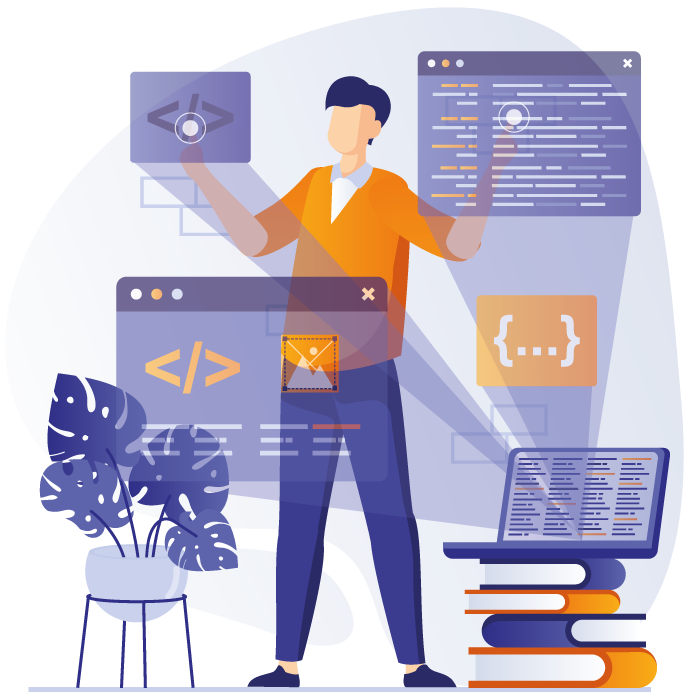Expertise
With years of experience in the industry, our team is well-versed in a variety of programming languages and technologies. We have the expertise necessary to create custom applications that are tailored to the specific needs of our clients.
Looking for a reliable custom application development company? Look no further than SoftwareHouse.Pro! We specialize in creating custom applications that meet the unique needs of our clients. Our team of expert developers has years of experience in developing cutting-edge applications that are tailored to meet specific business requirements.
We use the latest technologies and development methodologies to ensure that your application is both scalable and reliable. Our developers work closely with clients to ensure that the application meets all of their needs, from design to deployment. Whether you need a custom web application or a mobile app, we have the expertise to make it happen.
At SoftwareHouse.Pro, we pride ourselves on our commitment to delivering high-quality applications that exceed our clients' expectations. We work closely with our clients throughout the entire development process, providing regular updates and incorporating feedback as needed. We also provide comprehensive testing and support services to ensure that the application runs smoothly and meets all of your business needs.
So if you're looking for a custom application development company that can deliver results, look no further than SoftwareHouse.Pro. Contact us today to learn more about our services and how we can help take your business to the next level.


At SoftwareHouse.Pro, we specialize in custom application development to help businesses achieve their unique goals. Our team of experienced developers and designers is dedicated to creating customized applications that are tailored to meet the specific needs of our clients. From initial ideation to final deployment, we work closely with our clients every step of the way to ensure that their vision is realized.
When you choose to work with us, you can trust that your project is in good hands. We pride ourselves on providing top-notch customer service, timely delivery, and high-quality work. We also understand the importance of transparency and effective communication, and we will keep you informed throughout the entire development process.
Whether you need a custom application for your internal business processes or a consumer-facing app, we have the expertise to deliver results. Our team is skilled in a variety of programming languages and development frameworks, and we are always staying up to date with the latest technologies to ensure that our clients are receiving the best possible solutions.
Don't settle for a one-size-fits-all solution - let SoftwareHouse.Pro help you build a custom application that fits your unique needs. Contact us today to learn more about our custom application development services.
With years of experience in the industry, our team is well-versed in a variety of programming languages and technologies. We have the expertise necessary to create custom applications that are tailored to the specific needs of our clients.
We understand that each client has unique needs and goals. That’s why we work closely with our clients to ensure that their vision is incorporated into the final product. Our collaborative approach ensures that the end result is a custom application that meets the unique needs of our clients.
We understand that time is money in the business world. That’s why we prioritize efficiency in our custom application development process. Our team works diligently to ensure that projects are completed on time and within budget, without sacrificing quality.
At SoftwareHouse.Pro, we pride ourselves on delivering high-quality custom applications. We utilize the latest technology and programming languages to ensure that our custom applications are reliable, scalable, and secure.
Custom application development is a critical aspect of modern business operations. It provides organizations with a competitive advantage by creating unique and tailored software solutions to meet specific business needs. SoftwareHouse.Pro is a leading custom application development company that offers a wide range of services to help organizations build effective and efficient software solutions. In this article, we will explore the benefits of custom application development and how SoftwareHouse.Pro can help businesses achieve their goals.
Custom application development involves designing and building software that is specific to the needs of an organization. Unlike off-the-shelf software, custom applications are tailored to the specific requirements of a business, enabling them to address unique challenges and opportunities. Custom software solutions can help organizations automate processes, enhance productivity, and provide better customer experiences.
SoftwareHouse.Pro offers a comprehensive range of custom application development services to meet the specific needs of businesses across various industries. Our team of experienced developers works closely with clients to understand their needs and design software solutions that address their unique challenges. We offer a range of services, including application development, application migration, application integration, and application support and maintenance.
Our application development services help businesses build custom software solutions from scratch. Our team of developers works closely with clients to understand their needs and design software solutions that meet their unique requirements. We use the latest technologies and best practices to ensure that the software we develop is scalable, secure, and efficient.
SoftwareHouse.Pro offers application migration services to help businesses migrate their legacy applications to modern platforms. Our team of experts helps organizations identify opportunities to enhance and modernize their legacy systems, improving efficiency, and reducing costs.
Our application integration services help businesses integrate their software solutions with existing systems and platforms. We have experience integrating complex enterprise systems, including CRM and ERP systems, ensuring seamless communication and data sharing between systems.
SoftwareHouse.Pro's application support and maintenance services ensure that the software we develop remains efficient, effective, and secure. Our team of experts provides ongoing support and maintenance services, including bug fixes, updates, and enhancements, ensuring that the software we develop remains relevant and effective.
At SoftwareHouse.Pro, we are committed to delivering high-quality custom application development services that meet the unique needs of our clients. Our team of experienced developers uses the latest technologies and best practices to ensure that the software we develop is scalable, secure, and efficient. We work closely with clients throughout the development process to ensure that the software we develop meets their unique requirements. Our commitment to excellence has made us a trusted partner for businesses across various industries.
Custom application development is critical for businesses seeking to gain a competitive advantage in today's fast-paced and complex business environment. SoftwareHouse.Pro is a leading custom application development company that offers a comprehensive range of services to help businesses build effective and efficient software solutions. Our team of experienced developers works closely with clients to understand their needs and design software solutions that address their unique challenges. Contact us today to learn how we can help your business achieve its goals through custom application development.
Are you struggling with the limitations of off-the-shelf software? Do you need a customized application to address your unique business needs? At SoftwareHouse.Pro, we understand that every business is unique and requires tailored solutions. Our custom application development services can help you achieve your goals and improve your business processes.
At SoftwareHouse.pro, we offer a suite of services designed to propel your business forward, combining innovative technology with deep industry expertise for unmatched results.